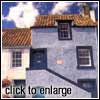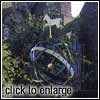|
East Neuk
The East Neuk villages are very close to one another
and can be covered quite easily in a day. Three miles (5km) north-east along the
coast from Elie is St Monans. This was a thriving fishing port making its living
mainly from herring fishing and processing. Miller's boat-yard by the harbour is
one of the oldest surviving boat-builders, established in 1747 and still producing
fishing vessels today. St Monans parish church sits close to the sea-edge, a picturesque
little building with its history connected to the time of David I. Inside, suspended
in the transept, is a model of a full-rigged ship. This and the sound of breaking
waves just outside the church remind the congregation of the area's long links with
the sea.
 Pittenweem is the home of the Fife fishing fleet and has a
new fish market and refurbished granary containing the all-important ice-house. The
harbour can be a bustling scene with fishing boats landing their catch early in the
morning. The occasional brave seal will pop its head up in the harbour looking for
scraps. Pittenweem is the home of the Fife fishing fleet and has a
new fish market and refurbished granary containing the all-important ice-house. The
harbour can be a bustling scene with fishing boats landing their catch early in the
morning. The occasional brave seal will pop its head up in the harbour looking for
scraps.
At the start of the eastern breakwater, the Gyles,
not open to the public, is a pleasant corner of sixteenth and seventeenth century
houses restored by the National Trust for Scotland, a good example of the Dutch influence
that this part of Fife is known for. Kellie Lodging, the distinctive honey-coloured
tower in the High Street, has also been restored by the Trust, its ground floor occasionally
open as an art gallery.
Found in Cove Wynd overlooking the harbour, St Fillan's
Cave was a refuge for the seventeenth century Christian missionary, St Fillan. He
lived in the cave and the site became a shrine to later pilgrims. This simple dwelling
also gave the town its name. In the Pictish tongue, Pittenweem means place of the
cave. The key to the cave is available from the 'Gingerbread Horse' gift shop and
cafe in the High Street.
 Three miles (5km) inland from Pittenweem, near the tiny village
of Arncroach stands Kellie Castle. The Oliphant family owned this castle for two
centuries before it was sold to the Earl of Mar and Kellie in 1613. It lay abandoned
until taken over and restored by Professor James Lorimer, a distinguished legal expert.
On holiday in Fife in 1877, he discovered Kellie Castle on a walk, windowless and
deserted, practically a ruin. The professor and his family fell in love with it and
acquired it from the Earl of Marr as improving tenants, which they certainly proved
to be. Three miles (5km) inland from Pittenweem, near the tiny village
of Arncroach stands Kellie Castle. The Oliphant family owned this castle for two
centuries before it was sold to the Earl of Mar and Kellie in 1613. It lay abandoned
until taken over and restored by Professor James Lorimer, a distinguished legal expert.
On holiday in Fife in 1877, he discovered Kellie Castle on a walk, windowless and
deserted, practically a ruin. The professor and his family fell in love with it and
acquired it from the Earl of Marr as improving tenants, which they certainly proved
to be.
The walled harbour of Anstruther, known locally as
'Anster,' once contained Scotland's main fishing fleet with over 1,000 boats until
the onslaught of deep sea trawlers and the demise of the herring stock. There are
now mostly leisure boats moored in the harbour but Anstruther still reflects on its
fishing past at the Scottish Fisheries Museum found at the head of the harbour. The
museum gives a unique insight into the life and work of a fishing community, with
the marvellous interiors of a typical fisherman's home. There is also a collection
of model fishing boats, fishing gear and equipment, maps and compasses, as well as
an aquarium.
Behind the museum in East Green is one of Fife's best
restaurants, the Cellar, which serves exceptionally fresh and well prepared seafood.
'Anster' also boasts a fine 9-hole golf course, located at the foot of Bankwell Road,
behind the Craw's Nest Hotel. The Craw's Nest is one of the better hotels in the
area where you can enjoy good food with a fine view over the Forth.
Between Anstruther and Crail on the B9171 road is
Scotland's Secret Bunker, an underground Nuclear War Command Centre, redundant since
the end of Cold War aggression. This is where central government and military commanders
would have run the country in the event of a nuclear war. The operations rooms of
the RAF and Royal Observer Corps as well as dormitories and broadcast studios have
all been left as they were during past decades of tension.
 Out of all Fife's East Neuk villages, the village of Crail
has the most picturesque harbour. From Crail's wide main street, steep cobble-stoned
wynds run down to it, this being the older part of the village. Painters and landscape
photographers spend hours here. The small anchorage caters mainly for lobster and
crab fishing boats and creel-markers are seen in the water all along the coast. Out of all Fife's East Neuk villages, the village of Crail
has the most picturesque harbour. From Crail's wide main street, steep cobble-stoned
wynds run down to it, this being the older part of the village. Painters and landscape
photographers spend hours here. The small anchorage caters mainly for lobster and
crab fishing boats and creel-markers are seen in the water all along the coast.
The upper streets of the village are more spacious
with the Tolbooth at its centre, behind which is the small Crail Museum and Heritage
Centre giving an insight into the burgh's history. Crail Preservation Society has
conserved this and many other fine buildings in the village. A mile or so north of
the village is Balcomie Links which sports two of the best 18-hole golf courses in
Fife.
In the summer, boats from Anstruther and Crail run
excursions to the Isle of May some 5 miles (8km) off-shore. The grandfather of Robert
Louis Stevenson built the existing lighthouse but the first lighthouse in Scotland
was built here in 1636. The island became a National Nature Reserve in 1956 and is
home to a large population of puffins, razorbills, shags, guillemots and kittihawks,
as well as many common grey seals.
|



